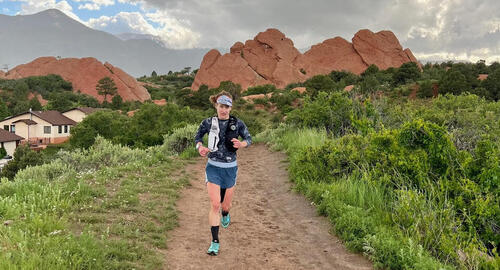Endurance sports tend to be solo pursuits, but we can stand to learn from the ‘hive’ mentality of competitive cyclists. There’s a reason they create pelotons. They can ride much more efficiently that way thanks to a drastic reduction in drag, and there’s the mental boost to be enjoyed from feeding off of each other’s energy.
The presence of other people can provide enough support (or distraction from pain!) to smash through false ceilings and challenge limiting beliefs that might stop you from even trying when you’re alone.
That said, you might not be able to access the same level of introspection in a crowd as you can in isolation. I wouldn’t want to miss out on all of the ideas that come to me 15 miles deep into a remote trail run. I also appreciate the ability to unabashedly channel my emotions into energy without worrying about what that looks like.
As a runner and rock climber, I’m grateful to have two outlets in my life that lie so far apart on the social spectrum. The combination helps me find the middle ground in both.
In running, it’s easy to revert to going solo all of the time. In climbing, it’s just as easy to default to buddying up. Most of the time, it makes sense for performance purposes to stick with the status quo. But the constant reminder that an alternative exists gives me the nudge I need to mix things up, so I don’t miss out on the benefits of what comes a little less naturally…
My rule of thumb
Every week, I flesh out my running and climbing training schedules with a combination of solo sessions and shared experiences. I’m methodical about how I divvy up those days. Group vibes don’t jive with every kind of run, and not all climbing objectives - even those that don’t require a belayer - feel comfortable without company.
I have a rule of thumb for deciding how to spread out social and solo training time:
If you want to go fast, go alone; if you want to go far, go together.
Camaraderie seems to have the greatest impact on my output when I’m going far. Good company makes the time fly by. Long distances also tend to trigger dramatic fluctuations in energy, emotion, and motivation. A lot can change over the course of so many hours spent singlemindedly grinding toward a barely conceivable goal. The knowledge that you won’t have to ride that rollercoaster of unknowns alone does wonders for stress management.
Plus, problem-solving is more effective with a partner. I tend to make quicker work of cruxes on sport climbs when I talk out my thought process with my belayer. Pacers serve the same purpose during long ultras. When your stomach turns or your hamstring starts talking, an outside perspective stops you from counting yourself out too soon.
When intensity takes precedence, company might feel more distracting than motivating. I like to enter that ‘pain cave’ on my own because I know that when I’m truly locked into my max, anything and anyone that’s even slightly out of line with my intended trajectory has to fade into the background.

It takes so much focus to continuously choose to keep moving through that level of discomfort, that sacrificing even a sliver of it results in performance losses. Your poor, desperate brain will latch onto any possible distraction as a way to stop you from putting yourself through the torture. How is it supposed to know that you’re choosing to feel this way?
Mental training goes a long way towards turning down the volume on outside distractions, so the temptation isn’t so strong. But why not make your job easier from the get-go? Unless you’re all on the exact same page, consider leaving your pals at home on HIIT day. You’ll appreciate their company more during lower intensity work when distraction actually serves you.
Why do you buddy up, buttercup?
Chit-chat does more than kill time. The very act of conversation keeps your heart rate low enough to stay in an effective aerobic zone based on evidence that the talk test can be used to regulate exercise intensity. If you find yourself consistently creeping up into higher heart rate zones anytime your eyes wander from your watch, recruit a friend or call your mum on easy days to hold you accountable to your breath.
And speaking of accountability, company makes it easier to get going in the first place. A study on exercise incentives noted that those with training partners visited the gym 35% more frequently than those without.
We all know that the first few minutes are often the hardest part of any training session, no matter what’s on the docket for the day. I line up training partners for sessions that I have trouble getting psyched for: dawn patrol runs when my circadian rhythms beg me to stay in bed or extreme weather conditions that guarantee a day defined by sweats or shivers. Creature comforts can be tough to resist in the moment, so I call on backup for the sake of ‘future me’.
Training with others can clue you into new tactics too. I swiped my favourite power-endurance climbing workout from a friend who showed me the ropes (literally) during a tandem gym session. I’ve also nipped my knee’s iliotibial band syndrome in the bud by pitter-pattering along behind my dad and emulating the stride pattern he learned during physical therapy. What works for someone else won’t always work for you, but it’s still valuable information to go on. Plenty of adult-onset athletes, like yours truly, never learned proper form during high school cross-country practice. Now’s our chance!
Go solo
Training alone means trading conversation for introspection. You can fill the void by tuning into your own body language. It’s an opportunity to learn how different effort levels feel, not just what the numbers are.

Rate of Perceived Exertion (RPE) works well as a self-regulatory tool in training because, with practice, it aligns with heart rate data while also taking individuality into account. One person’s 7/10 will differ from another’s. Until you understand how it manifests in your body, you’re a slave to metrics. Your body never stops talking; there’s often just so much else going on that it’s hard to make anything out. Solo training time quiets the noise.
Training partners are just that: partners. They can accompany you but they can’t do it for you. Endurance athletes need enough resilience to hold themselves accountable. How will you show up for that one last hill repeat when there’s no one else around to motivate you?
That’s the same attitude you’ll bring to the aid station at 2am when the idea of sleep, pizza, and a beer whilst sitting in the comfort of a camp chair sounds better than continuing to force your body forward. Not even the most enthusiastic pacer can make that call for you. By that point, enthusiasm won’t be enough to convince you anyway. Hone your inner drive during solo sessions.
All this aside, the “best” kind of training is the training you actually do. Sometimes that means squeezing it in where you can instead of waiting for the ideal scenario to play out.
If it’s a choice between braving the midday sun alone or skipping your session altogether, going solo will almost always serve you better than missing out. There were a good few years when the only time I was able to squeeze in a run was at 3pm on the dot in between split shifts at work. I had to cater to my own needs if I wanted to get the miles in. Would company have made some of those miles more productive? Maybe. But beggars can’t be choosers. Completion trumps perfection every time.
